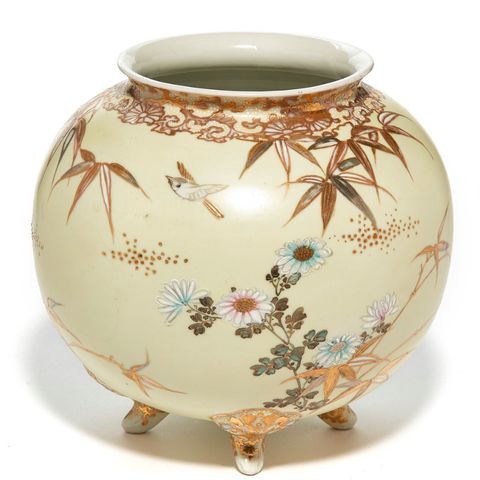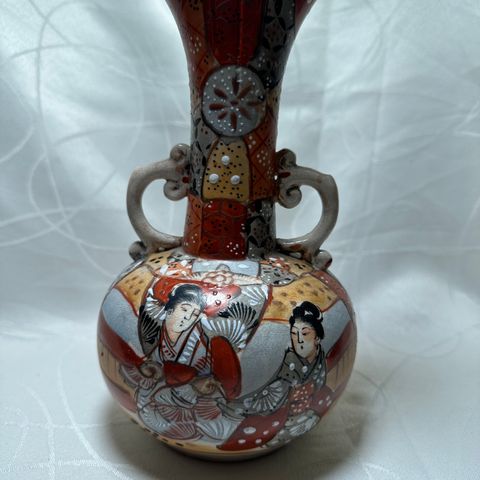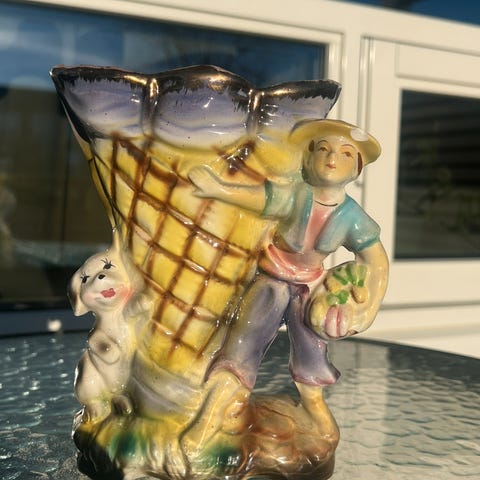Bildegalleri
Antikke Japanske vaser av flettet bambus
Beskrivelse av varen
Sjeldne vaser selges til gunstig pris!
Antikke japanske vaser med kurv av splittet, flettet bambus.
Høyde 20 cm, diameter ca 16 cm
Den ene vasen er i hvit porselen; den andre vasen er mørk.
Ingen synlige skader.
Vasene/kurvene er ganske like; litt forskjellig utforming på lokk og avslutning av fletting.
Sjeldne objekter, høyt priset på eBay og Etsy ( se foto).
Selges samlet kr 1750 evt hver for seg kr 950 pr stk
Japansk bambusfletting:
Bamboo weaving (竹編み, takeami) is a form of bambooworking (竹細工, takezaiku) and a traditional Japanese craft (工芸, kōgei), with a range of different applications, weaving styles and appearances. Japanese bamboo weaving is particularly well known for its use in basket weaving.
History
More than six hundred species of bamboo, some endemic to the island, grow in Japan. Although defined as a subfamily of grasses, bamboo is characterized by its woody culm and a root system that can form either thick, slowly spreading clusters or more aggressive runners.[1] Qualities such as the strength and flexibility of a bamboo variety differ widely, with some types considered more suitable for use in bamboo crafts than others. One such type especially used in bamboo weaving is Phyllostachys bambusoides, known as madake (真竹) or kashirodake (皮白竹), which is renowned for its combination of high strength and high flexibility.
Bamboo has characteristics which, over time, have led to its frequent usage in Japanese culture and the development of symbolism associated with its qualities. It is a fast-growing, straight-limbed and flexible plant, does not decay quickly once cut, and can be used for building shelters, weapons, instruments and containers. Young bamboo shoots, which are edible, form a part of traditional Japanese cuisine, and bamboo is a common theme in Japanese literature and painting.
Flower baskets for ikebana called hanakago (花籠) and other types were imported from China or their style copied. These karamono (唐物, lit.
'Chinese style') baskets had formal, symmetrical structures with tightly plaited weaves.[2][3] It was the 16th century tea master Sen no Rikyū (1522–1591) who advocated for a simple, austere wabi-cha style with natural and spontaneous or seemingly artless utensils. These tea utensils established a Japanese bamboo art distinct from the imported Chinese style.[2] Baskets were developed to appear in a natural, asymmetric style, called wamono (和物, lit. 'Japanese style').[2][3] Around 1700, the embrace of the steeped Japanese tea ceremony (sencha) coincided with a renewed admiration for Chinese culture, literature, and painting among the Japanese literati, a phenomenon that continued into the 19th century.[4]
Finely woven, elegant baskets imported from China served as models for karamono baskets now created by Japanese craftsmen, following a tradition established during the Muromachi period (1392–1573).[3] Recognition of bamboo craftsmanship as a traditional Japanese decorative art began at the end of the 19th century, and became accepted as an art form.
Brukerprofil

Du må være logget inn for å se brukerprofiler og sende meldinger.
Logg innAnnonsens metadata
Sist endret: 20.1.2025 kl. 12:16 ・ FINN-kode: 344131821



















